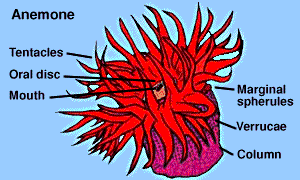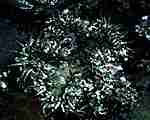|
|

Anemones
Anemones belong in the Phylum Cnidaria, related to hard and soft-corals and hydroids. Cnidarians were once called Coelenterates.

 Although
they have a flower-like form, anemones are efficient meat-eating carnivores,
capable of catching fish and small crustaceans by paralyzing them with
stinging tentacles and devouring their prey.
Although
they have a flower-like form, anemones are efficient meat-eating carnivores,
capable of catching fish and small crustaceans by paralyzing them with
stinging tentacles and devouring their prey.
Anemones have a hollow central column, capped by a flat oral disc fringed by tentacles armed with stinging nematocysts. The anemone to the right is a Waratah Anemone, Actinea tenebrosa.
 Some anemones, such as the Eastern Sand Anemone,
O. muscosa to the left, have sticky patches on the column, able to
hold sand grains and shell fragments. This may be a form of camouflage.
Some anemones, such as the Eastern Sand Anemone,
O. muscosa to the left, have sticky patches on the column, able to
hold sand grains and shell fragments. This may be a form of camouflage.
Although anemones may seem firmly attached to the rocks on which they sit, they are capable of very slow creeping from place to place.
Question:
Can think of any other reason why this anemone would be designed to have sand shell fragments stuck to it?
References
Bennett, I. (1987) W. J. Dakin's classic study: Australian Seashores. Angus & Robertson, Sydney.
Davey, K. (1998) A Photographic Guide to Seashore Life of Australia. New Holland, Sydney.
Edgar, G. J. (1997) Australian Marine Life: the plants and animals of temperate waters. Reed Books, Kew.
Quinn, G. P., Wescott, G. C. & Synnot, R. N. (1992) Life on the Rocky Shores of South-eastern Australia: an illustrated field guide. Victorian National Parks Association, Melbourne.
Marine Research Group of Victoria (1984) Coastal Invertebrates of Victoria: an atlas of selected species. Museum of Victoria, Melbourne.
Shepherd, S. A. & Thomas, I. M. (1982) Marine Invertebrates of Victoria, Pt. 1. South Australian Government Printer, Adelaide.
Underwood, A. J. & Chapman, M. G. (1993) Seashores: a beachcomber's guide. New South Wales University Press, Sydney.
Waratah
Anemone
Eastern Sand Anemone
Home
Page
Taxonomy
Biogeography
Rocky Shores
Tidal Levels
Intertidal Zonation
Environmental Factors
Biological
Factors
Feeding Relationships
Activities
Glossary
References
 Life
on Australian Seashores
Life
on Australian Seashores
by Keith Davey (C) 2000
Learning Consultant
- Media
The University of Newcastle
email at australian_seashores@hotmail.com
Scientific Consultant: Phil
Colman
site created 01.01.98 : updated 01.04.2000